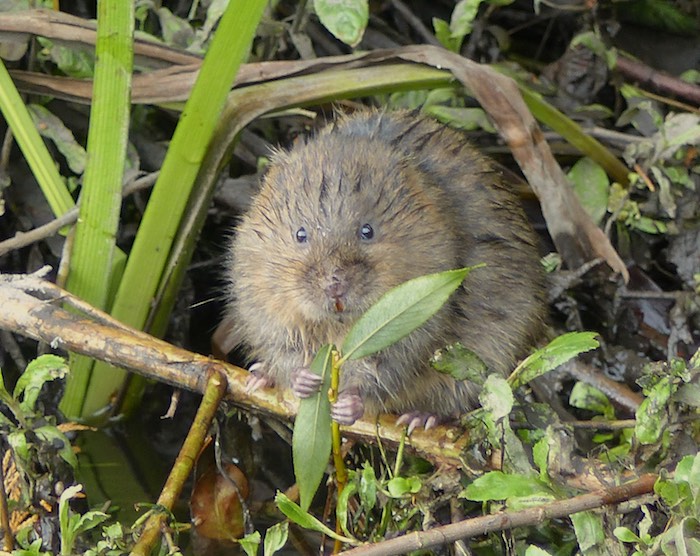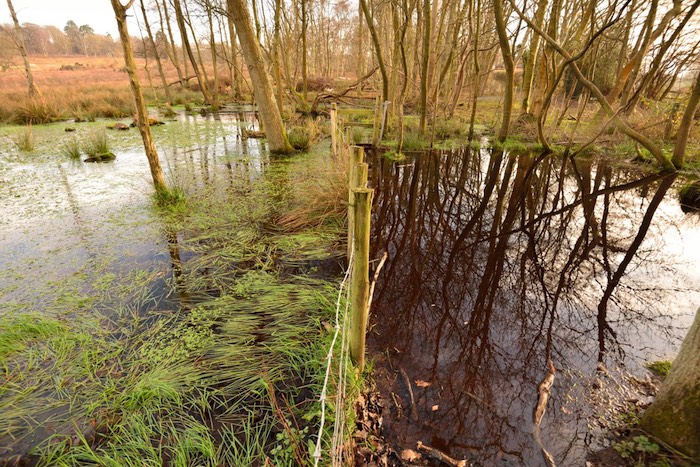The results of the latest England and Wales Water Vole Database and Mapping Project were launched in February this year. This is a national survey of water vole distribution run by The Wildlife Trusts.
The survey results show that they urgently need our help!
The top line of the report highlights a 30% decline in the distribution of water voles between 2006 and 2015 across England and Wales (even though the most recent survey period showed a slight increase).

The population is now estimated to be around 100,000 in England and Wales which is a catastrophic decline from the early 1800’s when there were 8 million of them and they were very common. They were still common during my childhood in the 1950’s and 60’s. Their huge decline has been caused by habitat loss, industrialised agriculture, pollution of waterways and predation by the American mink which was originally brought to the UK for fur farming.
How can we help water voles?
Water voles can be helped by local people working together (whether landowner, farmer, council or homeowner) to manage their reed-beds, ditches, streams, canals, rivers, lakes or pond habitat on their land for them. This can easily be achieved by leaving emergent vegetation and providing generous buffer strips of at least 2 metres of uncut vegetation (ideally 5M or more) to provide food, shelter and to reduce disturbance. It is essential that water voles are able to consume around 80% of their body weight in food each day, and a breeding female needs to be able to eat double that amount, otherwise they will fail to thrive! Sections of the bank need to be opened up to prevent over-shading and the banks need to have soft edges for water voles to be able to burrow into them. A mink monitoring programming would be necessary, too. A breeding female mink can eradicate an entire water vole colony in one breeding season. Any habitat management needs to be undertaken outside of the water vole’s breeding season which runs from March until the end of September, or early October. Advice on management can be found on the site here and https://www.wildlifetrusts.org/saving-species/water-voles
Why do weed need water voles in our waterways?
Water voles are vital for thriving wetland ecosystems and they cannot afford to lose them. It is not often realised that water voles are ecosystem engineers. These ‘mini beavers’ constantly manage and micro engineer waterways for the benefit of wildlife and us. Their foraging and burrowing increases biodiversity for the benefit of many species, including small mammals, many species of bees, butterflies, insects, insect-eating birds, bats and birds of prey. Their contribution to biodiversity is highly significant. A brook, stream or river without their work loses its wildlife richness and is a shadow of its former self. Research by the Universisty of Aberdeen has shown that waterways with increased species rich plant communities have higher numbers of water voles.
Water voles are vital wetland ecosystem engineers!
The Bow Valley’s WildSmart resource
To help wildlife in the Bow Valley, Alberta, Canmore residents have designated wildlife corridors for isolated populations of wildlife to move through their valley. Research undertaken by Senior Ecologist Melanie Percy, analysing over 1.5 million camera trap images taken of people and wildlife over 18 months, revealed that human disturbance is high. Melanie goes on to say:
“…94% of use being human, of which 61% are recreating with a dog. Of those people walking dogs, 60% of them have the dog off leash. So what that tells us is that we need to do a much better job at reducing those pressures on wildlife. Most people want to do the right thing, just like somebody living in the city would check the road conditions, or skiers would check the avalanche conditions before they go skiing. We have resources available to educate people where they should and should not be recreating, based on wildlife sensitivities.”
This resource is known as WildSmart. The most important part of the message for us begins at 10:12 to 13:24 mins:
Living With Wildlife from Leanne Allison on Vimeo.
Water vole waterways are also vital wildlife corridors
Although it is less obvious, water vole habitat is a wildlife corridor, too, which enables young water voles (and other wildlife) to travel and strengthen their gene pool by finding new colonies. This also enables them to build resistance to diseases. So always treat any wetland, waterway, or ditch, as if water voles are present and manage your land for them. If they are not present now, they could well be in the not too distant future following reintroduction programmes. Managing your land for water voles helps many other species, including pollinators, and small mammals such as bank voles, who in turn become prey for owls and kestrels.
It may be necessary to reintroduce water voles in some areas
Unfortunately, the national distribution of our much loved water voles is now highly fragmented and they are extinct in many counties. So you will need to contact the Wildlife Trusts to find out whether you have water voles, if you have not seen them. If you need help with identifying water voles and/or their field signs, please see our Quick Guide. If the water vole population in your county is fragmented by having too much distance between the sites, you may have to reintroduce them. To find out if this is necessary I would advise you contact Derek Gow who is an expert in reintroduction programmes.
We can be WildSmart about freshwater habitats too
Even what seems to be the harmlessness of letting your dog into ponds degrades them. The water becomes nutrient rich, so that vital plants for water voles to feed on, or insects to lay their eggs on are lost. The damage is much easier to see here, than the unseen disturbance that is caused to water voles.

Buglife’s report Neonicotinoid Insecticides in British Freshwaters (PDF download), published in December 2017, revealed that neonicotinoids (in the form of imidacloprid) are widely used as insecticides on dogs for fleas and ticks. When treated dogs enter water bodies, this water soluble insecticide contaminates and persists in the water and kills aquatic insects. Currently, topical medicines do not come with a warning to pet owners indicating that they should keep treated animals out of streams, rivers, ponds and lakes. It is also possible that insecticides taken internally are also harmful when they enter water via our pets. A permanent ban may be put in place both for topical and internal treatments, so keep an eye on Buglife‘s website.
Matt Shardlow, Buglife’s CEO, has advised that neonicotinoids are toxic to aquatic life down to 1 molecule in 10,000,000,000. This is serious, because aquatic invertebrate populations are an important part of our fresh water biodiversity. They recycle organic matter and keep our rivers clean for all aquatic life. In addition, the insects provide vital food for fish and birds. In the Netherlands, sharp declines in aquatic invertebrate abundance led to a 30% fall in bird numbers over 10 years.
“If we and the rest of the back-boned animals were to disappear overnight, the rest of the world would get on pretty well. But if the invertebrates were to disappear, the world’s ecosystems would collapse.” Sir David Attenborough
So we can help water voles, wildlife and plantlife by keeping to footpaths and by keeping our dogs on non-flexible leads. Also by making sure that our cats have collars with a bell or alarm. I have seen a collarless cat creep up on, catch and kill a juvenile water vole. This was an avoidable death.
LIVING WITH WILDLIFE IN THE BOW VALLEY, ALBERTA
It really is important for us as people to step back and say:
“Okay, what would life be like if we were not the centre of the universe?
How can we live differently?
And, at the end of the day, is it really that hard?”
Let’s follow the Bow Valley’s wonderful WildSmart example to help wildlife by taking extra care to minimise disturbance, whether in the countryside, or in a nature reserve. Like us, wildlife enjoy living in pristine, peaceful habitats, so that they are not constantly having to stop and check whether there is a threat. Then our wild kin will begin to thrive!
Please help spread the word by sharing this page:
